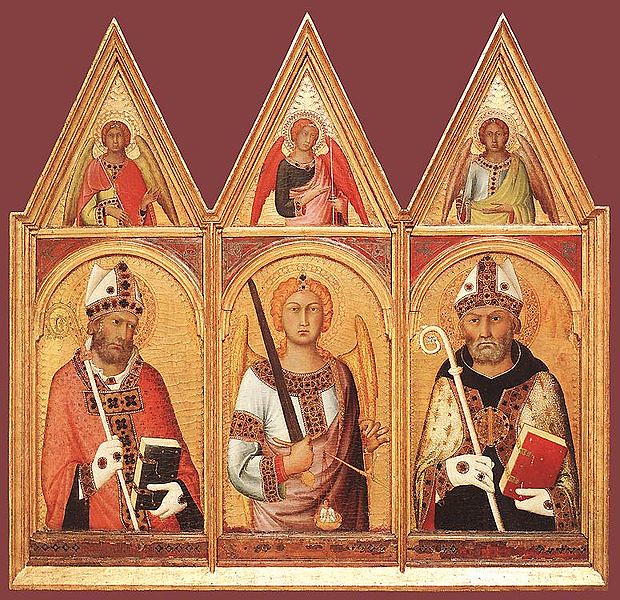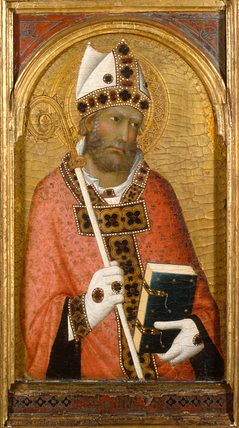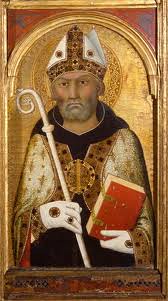Simone Martini's St Geminianus, St Michael and St Augustine.
 |
| Licensed via Wikimedia Commons. |
Two of the saints seem to be looking out of the picture but they are not really looking at us. Their gaze is directed beyond us, into some transcendental distance. Who knows what they see? Eternity? They are not of this world, after all.
St Geminianus
At left is this bishop: He is Saint Geminianus. He is the patron saint of the town of San Gimignano in the hills of Tuscany (that's his name in Italian: Gimignano). Look at the gorgeous detail of his punched halo (decorative patterns incised into the wood), the jewels on his mitre and his gloves, the clasps of his bible, and the curls of his beard.
 |
| Licensed via Wikimedia Commons. |
St Michael
Next comes the archangel Saint Michael. There are four archangels:
• Michael (who cast out Adam and Eve from the Garden of Eden)
• Gabriel (who is the angel of the annunciation and told Mary that she would give birth to God's son)
• Raphael (who travelled with Tobit, Tobias's son)
• and Uriel (who is not really well known at all).
 |
| Licensed via Wikimedia Commons. |
Michael also holds scales for weighing the souls on Judgement Day. You can see one tiny naked soul, praying. Look also at the delicately raised fingers that grasp the scales.
St Augustine
Finally, there's Saint Augustine, the famous 4th C. / early 5th C. theologian and author of the Confessions and City of God. (If you've read these, give them a go. I perused the Confessions a few years ago and found it a surprising page-turner. Augustine was a young Roman lay-about who liked to party hard before he had a conversion experience and then wrote about his life with great frankness in the Confessions.)
Anyway, back to the picture!
 |
| Licensed via Wikimedia Commons. |
The original context
Simone Martini was commissioned to make this painting for the Church of Saint Augustine in San Gimignano. The church is still there but the painting is there no longer.
Here is the church from the outside:
 |
| Church of St Augustine in San Gimignano, Tuscany © Sailko. Licensed via GNU Free Documentation License. |
And here is the church from the inside (imagine Simone's painting on the altar):
The original altarpiece
The three saints are part of a polyptych (a many-winged altarpiece). The polyptych originally had five panels. Three of the panels are in the Fitzwilliam. The central panel, a Virgin and Child, is now in Cologne, and another panel of Saint Catherine is in a private collection in Florence.
Here is a reconstruction of what the altarpiece looked like when it sat on an altar in Saint Augustine's church:
 |
| Source: Cologne museums |
It's not an overwhelmingly large painting. Perhaps it was located in a side chapel?
 |
| Source: Cologne museums |
 |
| Simone Martini, Virgin and Child, Wallraf-Richartz-Museum, Cologne. Licensed via Wikimedia Commons. |
 |
| Simone Martini, St Catherine, private collection, Florence Source: allart.biz |
All together
Here's my own recreation of what the five panels looked like all together:




What, when, where
What: St Geminianus, St Michael and St Augustine by Simone Martini.
Here's my own recreation of what the five panels looked like all together:




What, when, where
What: St Geminianus, St Michael and St Augustine by Simone Martini.
When: Painted around 1319.
Medium: Tempera paint and gold leaf on wooden panel.
Dimensions: Around 110 cm high. Each wing is around 38 cm wide.
(Info taken from Fitz catalogue.)
Medium: Tempera paint and gold leaf on wooden panel.
Dimensions: Around 110 cm high. Each wing is around 38 cm wide.
(Info taken from Fitz catalogue.)
Find out more by clicking on these sites:
• Fitzwilliam Museum site on Simone Martini (includes detailed info and a lovely Petrarch quote)
Part 1 of the advent series (Context): Virgin and Child by Andrea di Vanni.
Icons and Hindu religious art: Durga Puja
Do let me know if you liked this painting in comments. And if you've seen the other panels (in Cologne and in Florence), that would be very exciting to know! Hope you're having a peaceful second advent Sunday.
Permalink: http://artincambridge.blogspot.com/2012/12/advent-series-how-to-look-at-religious_9.html

This was really interesting. My mother was raised Catholic, so the saints were every present in our house. Down here, the Catholics are few and far between, most are not at all familiar with them!
ReplyDeleteThanks, Sorta Southern Single Mom! I emailed you separately: really interesting questions. :-)
ReplyDelete